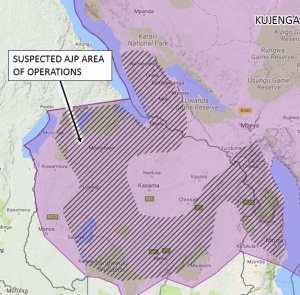Army of Justice and Purity
History
The AJP’s aggressiveness can be traced to the Government of Kujenga’s failed attempt to put them down in the mid-2000’s. The GoK reportedly attempted unting militant groups to break the momentum of the fledgling AJP and drive them out of the difficult-to-police Kasama region. The fractured militia operations ultimately failed, leading to resentful militias and a more resolute and capable AJP. In the years that followed, the AJP conducted retaliatory raids on villages in southern Kujenga. Regional and United Nation peacekeepers have attempted to capture Asari-Dokubo and disrupt the AJP with only limited success. Accusations of Kujengan military brutality against civilians and suspected AJP in the southern regions have swelled the AJP’s ranks and local support south of Mbeya. Despite their relative control of south Kujenga, the AJP regularly conducts raids and kidnappings.
In a 2007 speech attributed to Asari-Dokubo, claimed that the AJP's objectives are:
- To fight for the immediate restoration of competitive multi-party democracy in Kujenga.
- To see an end to gross violation of human rights and dignity of Kujengans.
- To ensure the restoration of peace and security in Kujenga.
- To ensure unity, sovereignty and economic prosperity beneficial to all Kujengans.
- To bring to an end to the repressive policy of deliberate marginalization of groups of people who may not agree with the Kujengan leadership’s ideology.
"Terrorist Group" Listing
The United States listed the AJP as a terrorist group in 2012 for its alleged widespread human rights violations, including murder, abduction, mutilation, child-sex slavery, and forcing children to participate in hostilities. The AJP continues local attacks to underline the inability of the government to protect the population. Violence in southern Kujenga that has been attributed to the AJP is consistent only in that it spreads fear and reinforces the perception of AJP control. AJP raids have been reported as far west as the Luafi Game Reserve and northeast in the Udzungwa Mountains.
A 2011 Kujengan government assessment claimed that the AJP had only 800 to 1,000 soldiers in total, but other sources estimated that there could have been as many as 3,500 soldiers, along with about 1,300 women and children. This number is likely less due to peacekeeping operations and recruiting problems. Regional media have reported that more than half of the AJP’s fighters are abductees.
Structure
There have been attempts by media and intelligence organizations to determine the specifics of their structure. The actual organization and strengths are difficult to discern with any accuracy and may vary substantially.
See also TC 7-100.3 Irregular Opposing Forces:
- Ch. 2 Insurgents - Higher Insurgent Organization
- Ch. 2 Insurgents - Local Insurgent Organization
- TC 7-100.3, Ch. 3 Guerrillas – Guerrilla Brigade
AJP use of Child Soldiers
The AJP has been harshly criticized for its use of child soldiers in direct combat. Most of the AJP's recruitment of child soldiers is through exploitation of vulnerable populations. Children in combat or for labor will likely have adult leadership present. These young fighters may exhibit a higher loyalty, ferocity , and acceptance of casualties.



